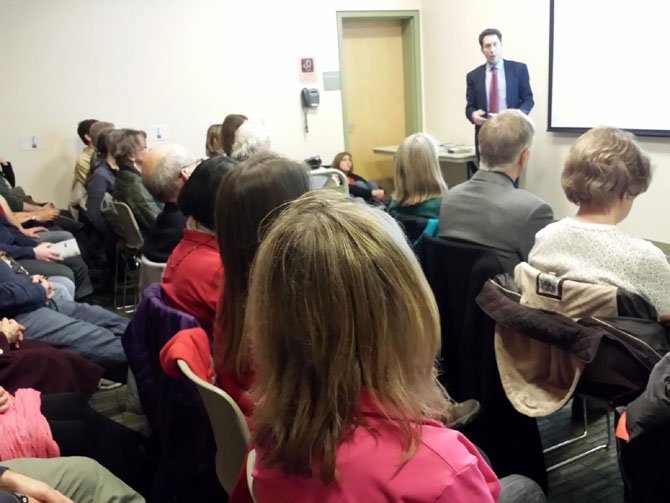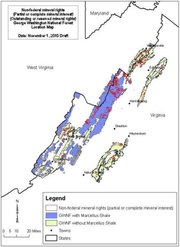Dustin Horwitt, a senior analyst at Earthworks, shares information about the proposal to drill for oil in the George Washington National Forest. Horwitt has been speaking at several town meetings across the area and informing residents on how fracking in the forest could impact drinking water in Northern Virginia. Photo courtesy of Linda Burchfiel.
At a town hall meeting in Burke, area residents, along with members of the Great Falls chapter of the Sierra Club, learned about fracking that could take place nearby in the George Washington National Forest.
Dustin Horwitt, a senior analyst at Earthworks, showed the audience the proposal for drilling in the George Washington National Forest, which has led to a number of environmental concerns.
The headwaters of the Potomac River are found within the million-acre forest. Drilling in the forest could cause risks to the drinking water used by over four million people in the D.C. area, including Fairfax County.
“There are countless tributaries that flow out of the forest and connect up to the Potomac,” Horwitt said.
Fairfax County Water Authority, the D.C. Water and Sewer Authority, and the Washington Aqueduct have voiced their opposition to fracking in the forest.
“It’s not just the forest service that has been concerned about this drilling and fracking,” Horwitt said. “Three of our major water providers have written to the forest service saying please do not allow this type of drilling in the forest because we are concerned it could contaminate our water supply here in Fairfax and the D.C. area.”
DURING THE COMMENT PERIOD on the draft forest plan for George Washington National Forest’s in 2011, Fairfax County Water Authority general manager Charles Murray wrote in a letter that Fairfax Water is concerned about the impact of drilling in the forest.
“It is imperative that decisions regarding oil and gas leasing be based on sound science and that the highest-level of protection be afforded sources of drinking water supply,” Murray wrote.
Trish Wotowiec, a resident of Burke, said she is working to convince the Fairfax County Board of Supervisors to pass a resolution voicing the county’s disapproval to the fracking plan. In early March, the Washington, D.C. City Council passed a resolution opposing fracking in the George Washington National Forest due to the possibility of it contaminating drinking water.
Attendees of the town hall meeting in Burke hope Fairfax County follows this example.
“This area is very politically active. We just need to make sure more people know about it,” Wotowiec said.
Linda Burchfiel of the Great Falls chapter of the Sierra Club encouraged attendees to write a letter to their supervisor, urging them to pass a resolution in favor of a ban on fracking in the George Washington National Forest.
The Forest Service estimates that half of the million-acre forest sits on top of the Marcellus Shale.
In 2011, the National Forest Service decided that horizontal drilling would be prohibited in the forest. Now, the agency is considering allowing fracking to occur.
“Since about 2012, the forest service has been on the brink of issuing its final decision, and they keep postponing it and postponing it. The most recent estimate they gave is that sometime this year, they are going to make the final decision,” Horwitt said. “We have to assume that they could make that decision at any time.”
Hydraulic fracturing has been around since 1947, but Horwitt said there have been major changes in the oil and natural gas industry over the last couple of years.
“One of the changes is that increasingly, companies are accessing what is called unconventional formations. The companies used to primarily drill in conventional formations, which is essentially a pool of oil and gas underground, like a bubble. The companies could perforate the pool with their drill bed and up would come the oil and gas,” he said.
Those formations, however, have for the most part been used. Companies have moved to shale, an unconventional formation.
“In these formations, the oil and gas is dispersed over a much larger area underground, and it’s locked up in the rock in millions of tiny pores. You need much more extensive drilling and fracking to access it,” Horwitt said.
According to Horwitt, these unconventional locations, including the Marcellus Shale, are located where people live.
“In unconventional formations, it takes a much more intensive process to extract the oil and natural gas,” Horwitt said. “In the George Washington National Forest, the forest service is predicting that they’ll have to use up to five million gallons of fluid injected into the well for hydraulic fracturing, and they’re predicting about 250 horizontal wells.”
Over the development of each oil pad, which includes three wells and could take several months, Horwitt said the forest service is predicting 4,400 truck tricks per well and up to hundreds of thousands of gallons of waste water per well.
“Most of that truck traffic is going to be bringing in the fluid for the hydraulic fracturing and then hauling out the waste water for disposal,” Horwitt said.
Opponents to fracking in the forest are concerned that spills could occur during fracking and that the water waste disposal could also cause problems.
“There’s so many trucks and equipment on each site that spills are basically inevitable,” Horwitt said.
THE OIL AND GAS INDUSTRY has said that fracking is safe, and that concerns about its safety are not based on fact. Proponents also argue that it creates jobs.
“We need the jobs, energy and tax revenues. This can be done with minimal impact to the environment and recreational uses of the forest,” Gregory Kozera, president of Virginia Oil and Gas association, wrote in a letter in 2011.
A couple of public figures in Fairfax County, including state Del. Patrick Hope (D-47), and Don Beyer, former Virginia lieutenant governor, have voiced their opposition to fracking in the George Washington National Forest.
For now, members of the Sierra Club and area residents are continuing to write to their supervisors.
“We’re hoping to get a board resolution. Fairfax County speaking as a whole is better than just us sending letters as individuals,” Burchfield said. “This is our chance to influence them.”
Braddock District Supervisor John Cook said that he has not yet been briefed on the situation and is unsure when a resolution would occur, although he is familiar with some of the news related to the possibility of fracking in the George Washington National Forest.

